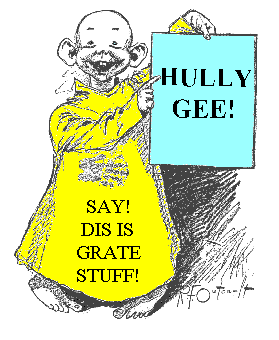Starting the Discussion
The Language
of Animation: Graphic Narrative, Sound and the Gag
Klein,
pp. 1-31
- Let's start with one
of the very basic premises of the course, as voiced by Klein on p. 1: "Cartoons
are a record of consumer rituals over the past 70 years . . . of the streets
and stores where audiences shopped and of the interior of the consumers' homes.
. . . They bear witness to the best and worst of American mass culture, condensed
into small, brilliantly manipulated blasts of imagery." We'll be discussing
this statement in class.
- What does Klein mean
by the term "graphic narrative"?
- Looking at the frames
on p. 4, jot down the qualities you can observe that give this cartoon a different
look from those made during the sound era. In what sense do the frames reflect
a graphic art medium, one concerned more with surface, rhythm
and line than with story or realism?
- What did early animation
take from the newspaper comics that preceded them? If you aren't sure what
comics would have looked like in the early 20th century, you can take a look
at one of the most popular, Krazy
Kat (1911). To go back a bit farther, you should look go to the R.F. Outcault
page. Outcault was the cartoonist who drew some of the the earliest newspaper
comics in the US, and his famous character,
The Yellow Kid (aka Mickey Dugan) can be seen in the cartoons (dating
back to 1894) as you scroll down the page. (He's the short, bald kid in a
sort of blousy yellow shirt.)

- What's the connection
between the early evolution of the animated cartoon and the increasingly industrialized
world of the 20th century?
- According to Klein, what
difference did sound make to the financial viability of theatrical cartoons?
- Why was sound so easily
integrated into cartoons, when the transition from silent to sound was so
difficult for live action films?
- Early film critics characterized
cartoons as "rich crumbs to the imagination"; why?
- What is lost from cartoons
when they become more imitative of the real world, more "photographic"
in Klein's terms? What were the advantages of being "a moving sketch,
with a frantic life of its own?
- Be ready to discuss the
following in class: "[Cartoons] have a distinct sociological value. They
exhibit man in society caught in a network of events . . . trying to escape
the consequences. They are in fact a comment, a very witty, instructive and
biting comment on the absurdities of Man and other living things seen in the
light of materialism. At the same time, they are human, tragic and comic."
(p. 10)
- In what sense is the
atomic unit of cartoons the gag? What does Klein mean by the word gag?
- How did vaudeville routines influence the gag-based structure of early animation?
What does it mean to say the narrative is associative in a cartoon?
- To go back to question #5, how did American culture of the early 20th century
play out the conflict between the more ethnic-based urban experience and the
memories of a more rural 19th century past? How did both cartoons and vaudeville
reflect this conflict?
- "Indeed, gags are more than random snatches of comic relief. They are
fables about surviving in an industrial world when the mind is still trapped
inside a rural community (p. 27)." Explain.
- When did gag-based (fragmented) storytelling begin to give way to more narrative
based cartoons?
Today we'll be looking at
the following cartoons in class:
Out of the Inkwell: Fishing (1921)
Felix Woos Whoopee
(1928)
Plane Crazy (1928)
The Skeleton Dance (1929)
Back
to Home Page

